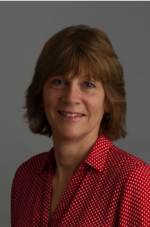
Research in the group of Dr. Janet Morrow focuses on applications of metal ion complexes in biology and in biomedical imaging. Her research is multidisciplinary and has an emphasis on ligands synthesis, inorganic coordination chemistry, spectroscopy and imaging, as well as studies in cells and in animals. Professor Morrow is UB Distinguished Professor of Chemistry and Larkin Chair at the University at Buffalo, the State University of New York.
Professor Morrow received her B.S. in Chemistry at the University of California, Santa Barbara and her Ph.D. in Inorganic Chemistry at the University of North Carolina, Chapel Hill. From there she did postdoctoral work for three years, first at the University Bordeaux, France on a NSF postdoctoral fellowship and then at the University of California, San Diego. She started her independent career at the University at Buffalo, State University of New York in 1988, and moved up through the ranks to Professor of chemistry and then to UB Distinguished Professor. Her research interests are in the field of bioinorganic chemistry with a focus on transition metal ion complexes in biomedical imaging. Her research contributions have been recognized with several awards, including the American Chemical Society Schoellkopf Medal, UB Exceptional Scholar, Alfred P. Sloan fellowship, NIH First award and the NSF Special Award for Creativity. She is currently an associate editor of the ACS journal, Inorganic Chemistry.
Her lab currently works on several projects. A long-standing interest is the development of chemical probes that respond to changes in biological environment for applications in molecular imaging. For example, probes that register extracellular tumor pH or redox status may be important in the characterization of metastatic tumor aggressiveness. These probes typically involve Co(II) and may be incorporated into liposomes or polymers. A second project involves the study of high spin Fe(III) complexes as alternatives to Gd(III) contrast agents. The Fe(III) may be part of a macrocyclic complex or contained within a metal organic polyhedral framework and are studied in mice by MRI. Finally, cellular uptake of paramagnetic iron complexes into cells, especially yeast, is under study. Labeled cells are characterized by using fluorescence microscopy and MRI towards cell tracking applications.
Janet Morrow will be at the chemistry department at ENS as an invited professor in 2020, from January 6 to 17 and May 11 to 23. Her lecture will be held at the chemistry departement of ENS (24 rue Lhomond, see rooms below)
Her programme for January:
-January 7, Tuesday, (10am45-12am45), room E012 (lecture with L3 and M1) : “Biomedical applications of inorganic chemistry: balancing academics, companies and life”
-January 8, Wednesday 10am-12am, room E012, Lecture 1 with L3. “Inorganic chemistry in biology and biomedicine”
-January 9, Thursday 11am-12 am, room E012: Research seminar in the series Colloquiumat the chemistry department “Iron and Cobalt MRI contrast agents for cell tracking and animal imaging”
January 9, Thursday 4pm15-6pm15, room E122: Lecture 1 with M1 “Paramagnetic probes for biomedical imaging I: fundamentals, and coordination chemistry”
January 13, Monday, 2pm-4pm, room E122 Lecture 1 with M1. “Paramagnetic probes for biomedical imaging II: smart agents and animal imaging”
